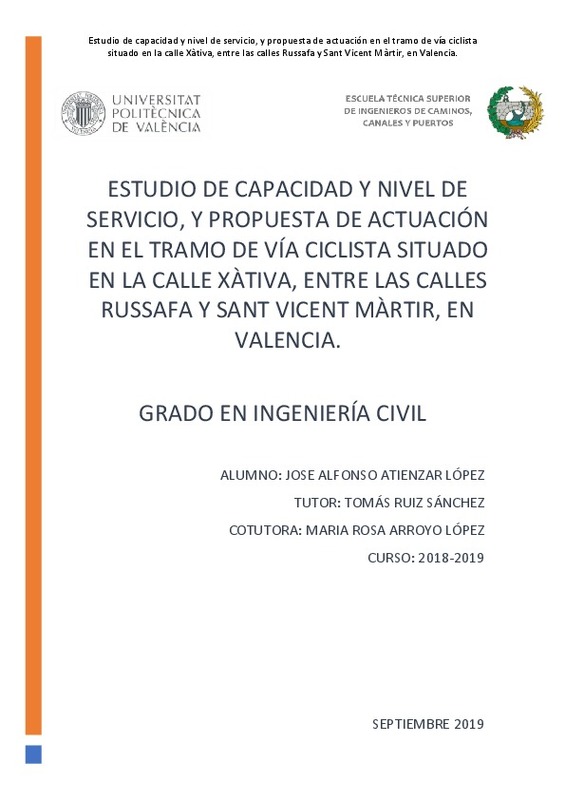|
Resumen:
|
[EN] The objective of the final degree work is to check whether the current infrastructure of the section of the cycle lane in Xàtiva street is sufficient to absorb current and future demand, through the application of ...[+]
[EN] The objective of the final degree work is to check whether the current infrastructure of the section of the cycle lane in Xàtiva street is sufficient to absorb current and future demand, through the application of methodologies used in the professional sphere, taking into account the context in which the cycle lane is located within the city of Valencia.
The methodology for calculating the level of service is included in the "Highway Capacity Manual" while the fieldwork methodology consists of a photographic report and data collection by means of gauges to apply the HCM methodology. For this purpose, data have been taken on the address, type of user and vehicle used, on different days and time slots.
The results of the current situation have been that the section studied has service level C, which corresponds to meeting current demand, but has no real capacity to absorb new users, while the analysis of the future situation results in service level D, which implies numerous conflicts and a reduction in speed.
In order to solve it, actions are proposed such as: deleting the central line, giving cyclist preference at junctions, banning vehicles other than bicycles and increasing the width of the lane.
The solution finally adopted is to give cyclist preference at junctions, which increases the fluidity of the section and increases the width of the bicycle lane, resulting in optimum service levels for the current and future situation.
[-]
[CA] L'objectiu del treball final de grau és comprovar si la infraestructura actual del tram de carril bici del carrer Xàtiva és suficient per a absorbir la demanda actual i futura, mitjançant l'aplicació metodologies ...[+]
[CA] L'objectiu del treball final de grau és comprovar si la infraestructura actual del tram de carril bici del carrer Xàtiva és suficient per a absorbir la demanda actual i futura, mitjançant l'aplicació metodologies utilitzades en l'àmbit professional, tenint en compte el context en el qual es troba el carril bici dins de la ciutat de València.
La metodologia per al càlcul del nivell de servei és la inclosa en el "Highway Capacity Manual" mentre que la metodologia del treball de camp consta d'un reportatge fotogràfic i de la presa de dades mitjançant aforaments per a aplicar la metodologia del HCM. Per a això s'han pres les dades de direcció, tipus d'usuari i vehicle utilitzat, en diferents dies i franges horàries.
Els resultats de la situació actual han sigut que el tram estudiat té un nivell de servei C, la qual cosa correspon al fet que compleix amb la demanda actual, però no té capacitat real d'absorbir nous usuaris, mentre que l'anàlisi de la situació futura dona com a resultat un nivell de servei D, la qual cosa implica un gran nombre de conflictes i una reducció de la velocitat.
Per a solucionar-ho, es proposen actuacions com: esborrat de la línia central, donar preferència ciclista en els encreuaments, prohibir vehicles diferents de la bicicleta i augmentar l'ample del carril.
La solució que s'adopta finalment és donar preferència ciclista en els encreuaments, la qual cosa augmenta la fluïdesa del tram i augmentar l'ample del carril bici, donant com a resultat uns nivells de servei òptims per a la situació actual i la futura.
[-]
[ES] El objetivo del trabajo final de grado es comprobar si la infraestructura actual del tramo de carril bici de la calle Xátiva es suficiente para absorber la demanda actual y futura, mediante la aplicación metodologías ...[+]
[ES] El objetivo del trabajo final de grado es comprobar si la infraestructura actual del tramo de carril bici de la calle Xátiva es suficiente para absorber la demanda actual y futura, mediante la aplicación metodologías utilizadas en el ámbito profesional, teniendo en cuenta el contexto en el que se encuentra el carril bici dentro de la ciudad de Valencia.
La metodología para el cálculo del nivel de servicio es la incluida en el "Highway Capacity Manual" mientras que la metodología del trabajo de campo consta de un reportaje fotográfico y de la toma de datos mediante aforos para aplicar la metodología del HCM. Para ello se han tomado los datos de dirección, tipo de usuario y vehículo utilizado, en diferentes días y franjas horarias.
Los resultados de la situación actual han sido que el tramo estudiado tiene un nivel de servicio C, lo que corresponde a que cumple con la demanda actual, pero no tiene capacidad real de absorber nuevos usuarios, mientras que el análisis de la situación futura da como resultado un nivel de servicio D, lo que implica un gran número de conflictos y una reducción de la velocidad.
Para solucionarlo, se proponen actuaciones como: borrado de la línea central, dar preferencia ciclista en los cruces, prohibir vehículos distintos a la bicicleta y aumentar el ancho del carril.
La solución que se adopta finalmente es dar preferencia ciclista en los cruces, lo que aumenta la fluidez del tramo y aumentar el ancho del carril bici, dando como resultado unos niveles de servicio óptimos para la situación actual y la futura.
[-]
|





![ZIP archive [ZIP]](/themes/UPV/images/zip.png)


